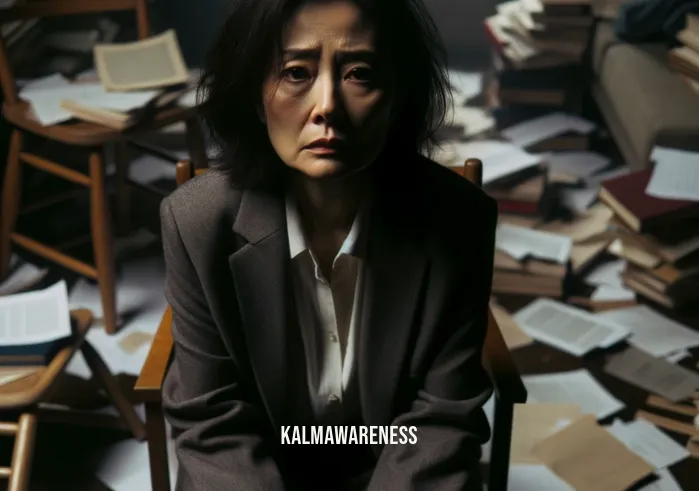Bipolar Disorder Meditation: Navigating Mood Management and Achieving Emotional Balance
In today’s fast-paced world, mental health is gaining increasing attention. With the rise of awareness comes a deeper understanding of the challenges faced by individuals with specific conditions. Bipolar disorder is one such condition that affects millions worldwide, characterized by alternating periods of elation and depression. However, amidst the plethora of treatments available, one holistic approach stands out for its promise in mood management and emotional balance: bipolar disorder meditation. This approach combines the age-old practice of meditation with modern insights into the psyche, offering a comprehensive solution to those seeking stability and coping mechanisms.
Mood Management Through Mindfulness
When one speaks of mood management, often the thought of pharmaceuticals and therapy sessions come to mind. However, mindfulness offers a more sustainable and organic route. Rooted in ancient traditions and now backed by modern science, mindfulness is about staying present, moment-to-moment, without judgment. This involves being aware of our thoughts, emotions, and physical sensations without getting overwhelmed by them.
For someone with bipolar disorder, this is invaluable. The volatile mood swings can be extreme, and having a tool that teaches you to observe these emotions without getting lost in them is crucial. By practicing meditation made simple, even beginners can cultivate this sense of presence, paving the path to emotional balance.
Stability Through Consistent Practice
Stability might seem elusive for someone experiencing the highs of mania and the lows of depression. Yet, the journey to stability can start with small, consistent steps. Many have found solace in grounding practices such as mindful movement sleep or even the gentle poses of rouse yoga. Moreover, understanding the element of some meditation exercises can also guide individuals towards a steadier emotional state.
But how exactly does one spell stabilize in the realm of bipolar disorder meditation? It begins with routine. Setting aside a dedicated time each day, perhaps with a guide like Jack Kornfield’s meditation for beginners, ensures that the practice becomes an integral part of one’s daily life, gradually promoting emotional and mental stability.
Coping with the Peaks and Troughs
Living with bipolar disorder isn’t just about managing moods; it’s also about developing coping mechanisms for those times when the emotions become too overwhelming. Here, a blend of awareness and actionable steps prove beneficial. Techniques such as mirror gazing for spiritual benefits or even the practice of gratitude meditation before sleep can offer solace during turbulent times.
Moreover, the power of perspective cannot be underestimated. When facing the trials of bipolar disorder, sometimes it’s essential to train your mind to be stronger than your feelings. This not only involves mindfulness practices but also consciously choosing to shift one’s perspective, focusing on the bigger picture rather than getting entangled in the momentary turbulence.
The Journey Ahead
As we delve deeper into the world of bipolar disorder meditation in the upcoming segments, we’ll explore the intricate relationship between emotional balance, mindfulness, stability, and coping. We’ll unearth techniques and practices that resonate, offer insights from experts in the field, and most importantly, share stories of those who have walked this path and found a semblance of peace and balance.
Embracing bipolar disorder meditation is not about negating the need for traditional treatments. Instead, it’s about complementing them, offering a holistic approach that addresses the mind, body, and soul. And as with any journey, the path is laden with its set of challenges and rewards. However, with the right tools and guidance, one can navigate this journey, finding moments of calm amidst the chaos.
So, as we set the stage for a deeper dive into this intriguing world of mindfulness and mental health, we invite you to join us in this exploration. Continue reading and embark on a journey of discovery, understanding, and, hopefully, healing.
Continue to the next segment for a deeper insight into the practices that have transformed lives and the science behind them.

Harnessing the Potential: Benefits and Techniques of Bipolar Disorder Meditation
Meditation, a practice deep-rooted in ancient traditions, has recently found its place in modern-day mental health support. Specifically, when it comes to bipolar disorder, this holistic practice promises transformative outcomes. As we delve deeper into the world of bipolar disorder meditation, it’s imperative to understand its nuances, benefits, and how one can incorporate it into daily life.
Unraveling the Core Benefits
While the previous chapter laid the groundwork on the significance of meditation for bipolar disorder, it’s essential to delve into specific benefits. Embracing such practices can make a profound difference in mood management and overall well-being.
Emotional Resilience: Individuals can better navigate the emotional highs and lows, building a buffer against intense mood swings. By training the mind through exercises such as mindful hypnobirthing, one can foster resilience.
Improved Sleep Patterns: A disrupted sleep cycle is a common symptom of bipolar disorder. Techniques such as gratitude meditation before sleep can promote restful nights.
Strengthened Self-awareness: Becoming aware of one’s thoughts and triggers is vital. Through practices that encourage sustainable self-care, an individual can develop an increased understanding of their mind.
Enhanced Coping Mechanisms: Armed with meditation techniques, individuals can face challenges head-on. Approaches that emphasize how we get deep so fast can be particularly beneficial.
Practical Techniques for Every Day
The journey towards mastering bipolar disorder meditation is paved with various techniques catering to different needs and preferences.
Body Awareness Practices: Grounding exercises such as touching that specific body part can help individuals stay anchored during turbulent emotional episodes.
Guided Meditations: Following along with expert-led sessions, like those by Jack Kornfield, can be immensely helpful for beginners.
Mantra-based Meditations: Repeating specific affirmations or phrases, drawn from sources like judgment of the wise, can foster a sense of calm and clarity.
Visualization Techniques: Using guided imagery or exercises such as mirror gazing can help in managing emotions and inducing relaxation.
Bipolar Disorder Meditation: A Snapshot
For a more structured overview, here’s a table that outlines the types of meditation techniques, their core benefits, and sources for deeper exploration:
| Meditation Technique | Core Benefit | Source for Exploration |
|---|---|---|
| Body Awareness | Grounding and Presence | Touch that body part |
| Guided Meditation | Structure and Guidance | Jack Kornfield |
| Mantra-based | Calm and Focus | Judgment of the wise |
| Visualization | Emotional Management and Relaxation | Mirror gazing |
With the myriad benefits and techniques available, it’s evident that bipolar disorder meditation offers a holistic and practical approach to managing the challenges faced by those with this condition.
Looking Forward
Meditation, with its myriad forms and profound benefits, holds promise as a complementary tool in the management of bipolar disorder. While we have delved into its core benefits and various techniques in this segment, the journey of exploration is far from over.
Continue reading to embark on a deeper exploration of personal narratives, scientific studies, and expert insights that shed light on the transformative power of bipolar disorder meditation.

Stories of Triumph: Bipolar Disorder Meditation’s Beacon of Hope
Meditation, as an art and science, transcends beyond mere practices. It’s a beacon, shedding light on those shrouded in the tumultuous storms of bipolar disorder. While the prior chapters underscored the techniques and benefits, this chapter aims to inspire by presenting stories of hope and perseverance tied to bipolar disorder meditation.
Voices of Transformation
Stories have the power to resonate, inspire, and propel individuals towards change. Let’s immerse ourselves in the tales of those who’ve found solace and strength through bipolar disorder meditation.
Alyssa’s Journey: Alyssa always found herself on an emotional rollercoaster. At the brink of despair, she stumbled upon mindful movement practices to aid sleep. The result? Not only did her sleep patterns regulate, but her mind began finding balance. As she eloquently put it:
“Meditation didn’t eliminate my struggles; it equipped me with the tools to face them.”
Mark’s Realization: Mark, an avid reader, found inspiration in the wisdom behind the judgment of the wise. Through mantra-based meditations, he unearthed a peace he never knew:
“In the echoing silence of my mind’s chaos, I found clarity.”
Naomi’s Turning Point: Naomi, a mother of two, experienced frequent manic episodes. Through mindful hypnobirthing techniques, she found grounding. In her words:
“It wasn’t about negating the highs or lows, but dancing gracefully with them.”
The Guiding Light of Meditation
It’s evident from such anecdotes that meditation is more than just a coping mechanism; it’s a compass guiding individuals through their darkest phases. But where does one begin? Resources like Meditation Made Simple and the core element of some meditation exercises provide a robust starting point.
Further, an integral component that bolsters the meditation journey is keeping certain affirmations in mind. Consider the words from a renowned meditation guide:
“Train your mind to be stronger than your feelings, and therein lies your sanctuary.” — Source
Finding Your Anchor
Every individual’s journey is unique. While Alyssa found solace in movement, Mark resonated with mantras. The beauty of bipolar disorder meditation lies in its vastness. Whether it’s the rhythmic cadence of Rouse Yoga or the introspective nature of mirror gazing, there’s a path for everyone.
However, as highlighted in how to spell stabilize, consistency is crucial. It’s not about a one-time epiphany but a continuous journey of self-awareness and growth.
Ahead in Our Journey
While this chapter illuminated the path with stories of transformation, our exploration is far from its zenith. Ahead, we’ll delve into the scientific underpinning of bipolar disorder meditation. From research findings to expert insights, the subsequent chapter promises a comprehensive understanding of the transformative powers of meditation. So, continue reading and enrich your quest for balance and well-being.

Unraveling the Mystique: The Core of Bipolar Disorder Meditation
The transformative power of bipolar disorder meditation is an amalgamation of ancient wisdom and contemporary practices. As we’ve journeyed through tales of inspiration and hope, it’s time to dissect the heart of the matter. Let’s dive deep into the core facets of bipolar disorder meditation, elucidating its components for a thorough understanding.
Foundational Principles of Meditation
To truly grasp bipolar disorder meditation, understanding its foundational principles is paramount:
Mindfulness: At the core lies mindfulness. It’s the art of being present, detaching from the past’s shadows and the future’s uncertainties.
Emotional Equilibrium: Meditation for bipolar disorder is not about suppressing emotions, but achieving a state in which thoughts are not occupied by worry.
Consistent Practice: Like any skill, consistency is key. One meditation session for each blessed day can pave the path to emotional balance.
Guided Techniques: Using resources, like the beginner’s guide by Jack Kornfield, can help navigate the intricacies of the practice.
Benefits Outlined
The advantages of bipolar disorder meditation are multifold. Let’s enumerate some pivotal benefits:
Stability: A primary goal, as mentioned in how we get deep so fast, is to achieve a sense of internal stability amidst external chaos.
Enhanced Coping Mechanisms: Through practices like sustainable self-care, one cultivates a toolkit to navigate life’s ups and downs.
Mind-Body Connection: It’s not just about the mind. Techniques like meditation lying down underscore the intricate connection between mind and body.
Heightened Self-awareness: By focusing inward, one gains profound insights into their emotional landscape, laying the groundwork for transformation.
Common Misconceptions
Like any practice shrouded in mystique, there are myths associated with bipolar disorder meditation:
“It’s a Quick Fix”: Meditation is a journey, not a destination. It’s not about instant results but continuous growth.
“One Size Fits All”: While the principle remains consistent, techniques can vary. For instance, the peacefulness achieved in gratitude meditation before sleep might differ from an active mindfulness session.
“It’s a Solo Journey”: Many find strength in group sessions, walking the path with fellow seekers, as seen in group practices like teenagers walking meditations.
The Road Ahead
While this chapter has attempted to demystify bipolar disorder meditation, the journey isn’t complete. As we approach our final chapter, we’ll encapsulate the essence, providing actionable insights and a roadmap for those keen on integrating meditation into their lives. Brace yourself for an enlightening culmination in our next segment.

Charting A Brighter Path: Bipolar Disorder Meditation’s Encompassing Embrace
As we stand at the crossroads of our enlightening journey, gazing back at the path we’ve traversed, it’s evident that the landscape of bipolar disorder meditation is as vast as it’s enriching. With its deep-rooted principles and transformative benefits, it offers a beacon of hope for many navigating the tumultuous waves of bipolar disorder.
The Guiding Light
Throughout our exploration, one fact has emerged with striking clarity: meditation made simple is a potent tool for those seeking emotional equilibrium. By fostering a sense of mindfulness, it doesn’t merely provide an escape but equips one with the skills to face challenges head-on.
The Tapestry We’ve Woven
From uncovering foundational principles to dismantling myths, our journey has been nothing short of enlightening:
We began by understanding the ethos of bipolar disorder meditation, a gentle union of mindful movement and restful sleep.
Delving deeper, we expanded our horizons, discovering the hope and inspiration that lies within the realms of meditation, reinforced by the judgement of the wise.
Further, we broke down complex concepts, ensuring every reader could grasp the intricacies and nuances of the practice.
Your Compass Moving Forward
Bipolar disorder meditation isn’t just a practice; it’s a lifestyle. Here are steps to embed it seamlessly into your life:
Stay Consistent: Remember the element of some meditation exercises we discussed? Consistency remains key.
Seek Community: Join groups or platforms that resonate with your goals. Engage in rouse yoga or any other group activities that foster a sense of belonging.
Be Gentle with Yourself: The journey has its ups and downs. In moments of doubt, revisit our section on how to spell stabilize for a refreshing outlook.
A Heartfelt Note of Gratitude
Dear readers, as we wrap up this enlightening expedition, a note of heartfelt gratitude is in order. Your engagement and curiosity have been the wind beneath our wings, propelling us to curate content that resonates and uplifts.
As we bid adieu to this chapter, remember, the journey of discovery never truly ends. While we’ve explored the myriad facets of bipolar disorder meditation, the vast expanse of the mind remains an open field. We urge you to delve deeper, explore more of our content, and embrace the art of meditation in its entirety.
Until our paths cross again, keep exploring, keep questioning, and most importantly, keep meditating. Here’s to a brighter, balanced tomorrow!





